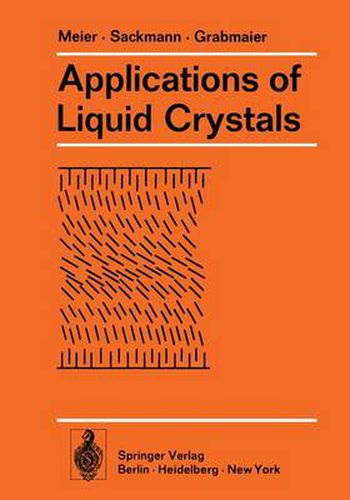Readings Newsletter
Become a Readings Member to make your shopping experience even easier.
Sign in or sign up for free!
You’re not far away from qualifying for FREE standard shipping within Australia
You’ve qualified for FREE standard shipping within Australia
The cart is loading…






This title is printed to order. This book may have been self-published. If so, we cannot guarantee the quality of the content. In the main most books will have gone through the editing process however some may not. We therefore suggest that you be aware of this before ordering this book. If in doubt check either the author or publisher’s details as we are unable to accept any returns unless they are faulty. Please contact us if you have any questions.
Over the past ten years liquid crystals have attracted much interest and considerable progress has been made with respect to our knowledge in this field. The recent development was initiated mainly by the work of J. L. Fergason and G. H. Heilmeier, who pointed out the importance of liquid crystals for thermographic and electro optic applications. The first part of this book is a brief introduction to the physics of liquid crystals. The structures and properties of the three basic types of liquid crystals are discussed. A special paragraph is devoted to electric-field effects, which are important in display applications. The chapter on Scientific Applications gives an insight into the potential applications of liquid crystals in fundamental research, with special emphasis on explaining the principles involved. Two groups of potential applications are discussed in detail: 1. the use of liquid crystals as anisotropic solvent for the determination of molecular properties by means of spectroscopy, and 2. their use in analytical chemistry, particularly in gas chromatography. The reverse process involves the use of the dissolved molecules as microscopic probes in the investigation of the dynamical molecular structure of anisotropic fluid systems (e.g. biological membranes). This extremely important technique is also described.
$9.00 standard shipping within Australia
FREE standard shipping within Australia for orders over $100.00
Express & International shipping calculated at checkout
This title is printed to order. This book may have been self-published. If so, we cannot guarantee the quality of the content. In the main most books will have gone through the editing process however some may not. We therefore suggest that you be aware of this before ordering this book. If in doubt check either the author or publisher’s details as we are unable to accept any returns unless they are faulty. Please contact us if you have any questions.
Over the past ten years liquid crystals have attracted much interest and considerable progress has been made with respect to our knowledge in this field. The recent development was initiated mainly by the work of J. L. Fergason and G. H. Heilmeier, who pointed out the importance of liquid crystals for thermographic and electro optic applications. The first part of this book is a brief introduction to the physics of liquid crystals. The structures and properties of the three basic types of liquid crystals are discussed. A special paragraph is devoted to electric-field effects, which are important in display applications. The chapter on Scientific Applications gives an insight into the potential applications of liquid crystals in fundamental research, with special emphasis on explaining the principles involved. Two groups of potential applications are discussed in detail: 1. the use of liquid crystals as anisotropic solvent for the determination of molecular properties by means of spectroscopy, and 2. their use in analytical chemistry, particularly in gas chromatography. The reverse process involves the use of the dissolved molecules as microscopic probes in the investigation of the dynamical molecular structure of anisotropic fluid systems (e.g. biological membranes). This extremely important technique is also described.